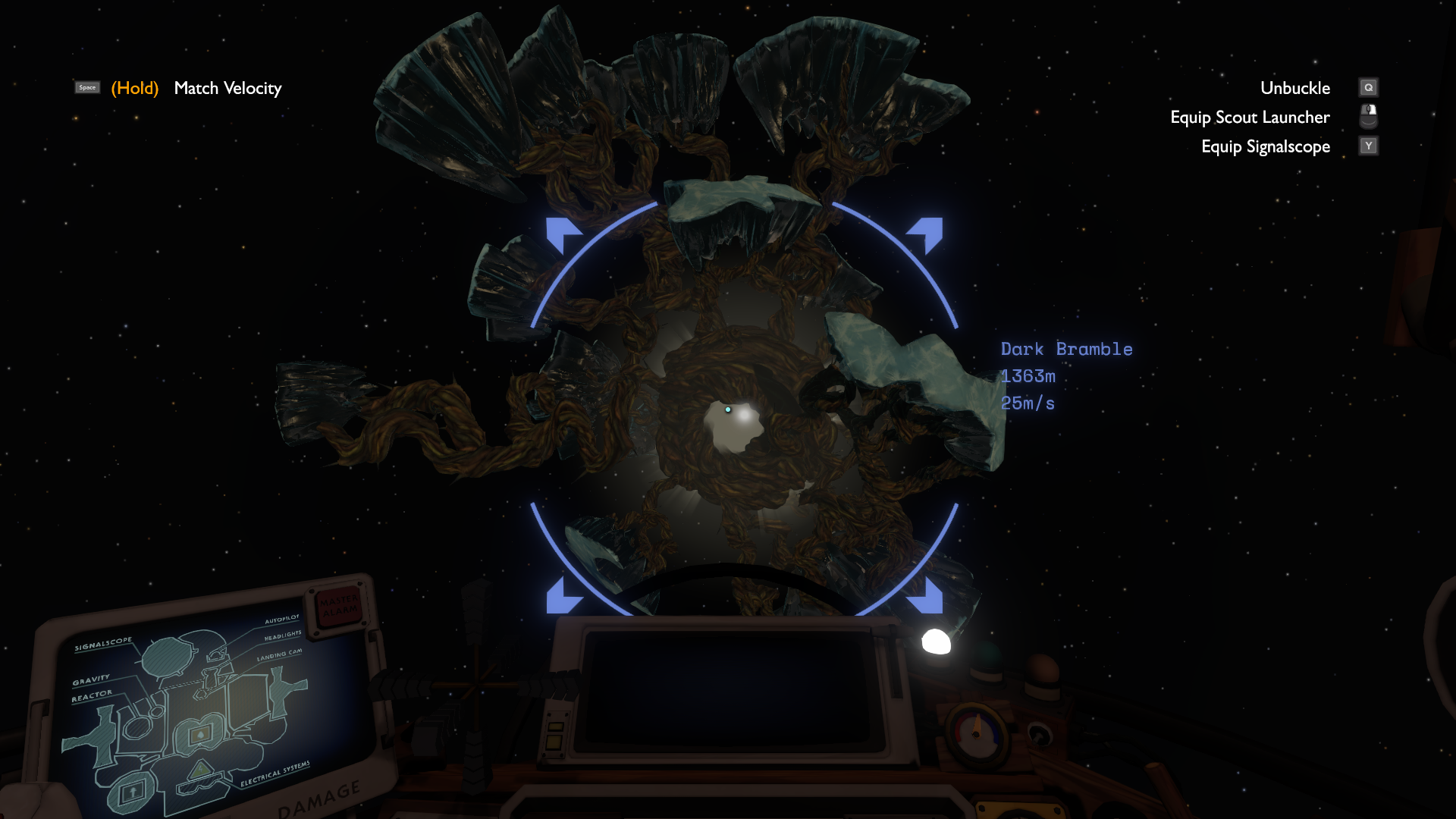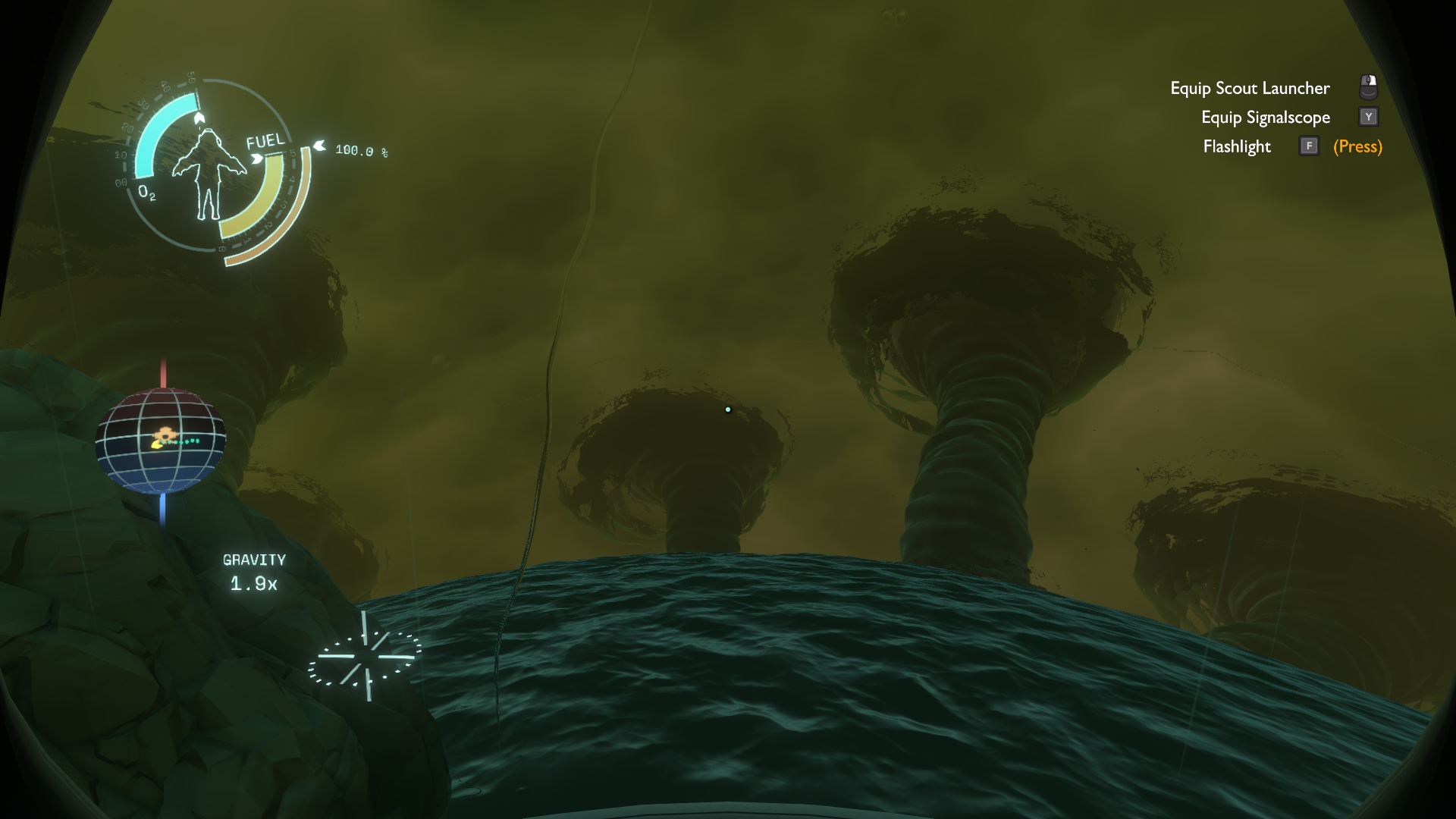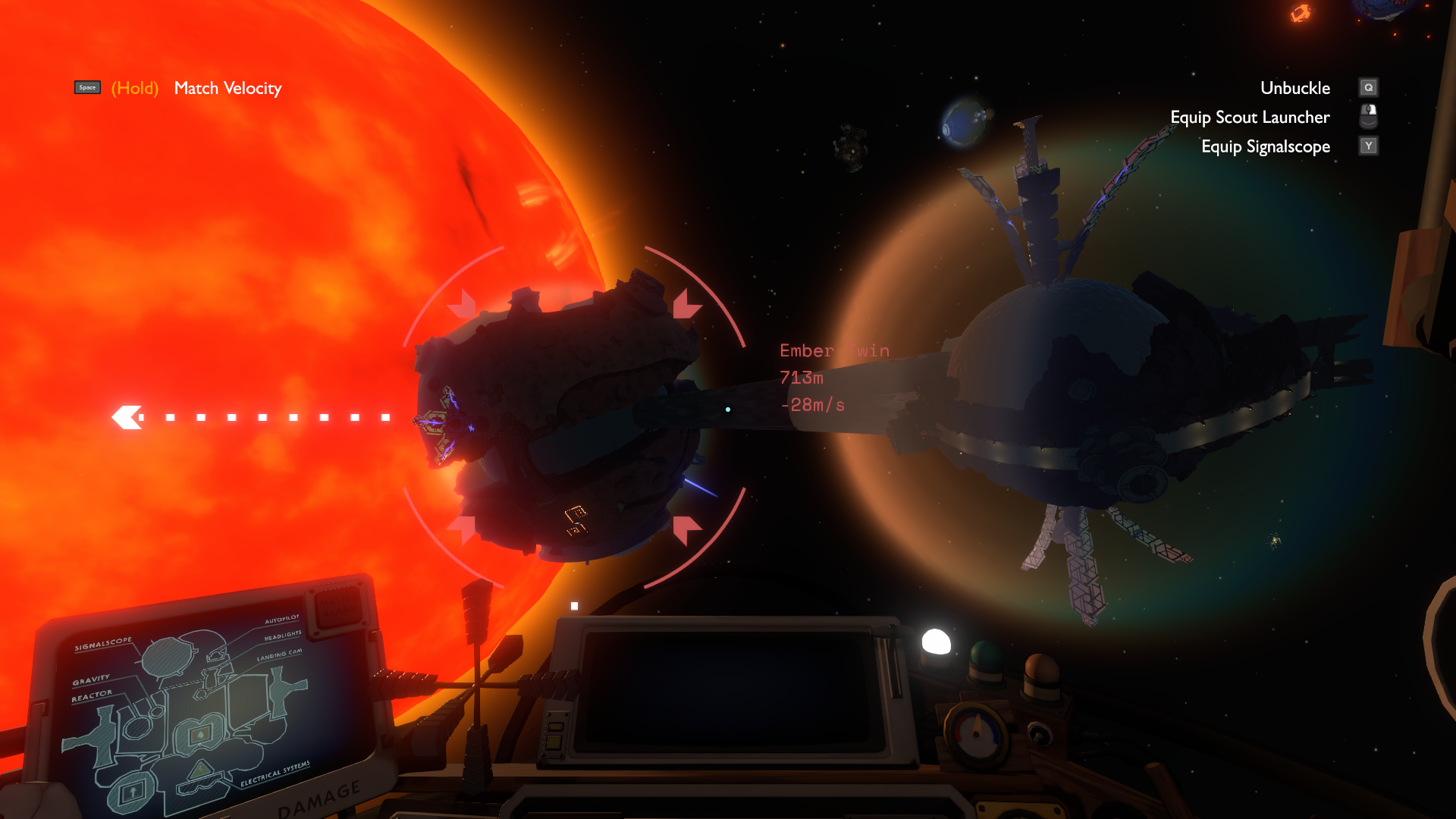Special Spoiler Warning! If you have ANY interest in playing Outer Wilds, turn back now and DO NOT READ. Outer Wilds is a fantastic game and this article spoils major plot points. READ ON AT YOUR OWN PERIL. SPOILERS AHEAD.
Outer Wilds is a game about exploring the solar system. You become exposed to a truly weird and wonderful place once you take off from your humble home of Timber Hearth. There’s a planet slowly being devoured from the inside out by a black hole, an orb of water covered with tornadoes that periodically throw its few islands spiralling into space, and a menacing web of twisted branches called Dark Bramble, sitting eerily at the very edge of known space.
The solar system is littered with the archaeological remnants of the Nomai, a species with technology that was far in advance of your own. Your spacecraft is haphazardly cobbled together, standing in stark contrast to the mastery of quantum technology that the Nomai seemed to possess. You read their excited conversations about science as you delve through the ruins, trying to make sense of all the disconnected bits of information that come your way.
And then, you die. The Outer Wilds are a dangerous place, and over the course of the game I suffocated, crashed into the sun. was eaten by giant angler-fish and was crushed upon impact with the ground. But even if you play carefully, and don’t take any risks, you’re going to die anyway. From the start of the game you have precisely 22 minutes until the sun erupts into a supernova and blasts the galaxy to pieces. Luckily for you, you’re a god.
The central gimmick of the game is that you’re stuck in a time loop. Every death, whether from the explosion of the sun or otherwise, sends you to the beginning of the loop. The only thing you keep is the knowledge you’ve uncovered, which is handily recorded in your ship’s computer. And so you venture forth, again and again, learning more with every journey and trying to put together the larger mystery of what’s happening and why.
The way in which you unmask that mystery will be different for every player. Outer Wilds embraces exploration, and lets you go to all of its planets and satellites in any order you choose. What it does, brilliantly, is put ‘knowledge gates’ on certain locations. Exploration for exploration’s sake is all well and good, but it feels more satisfying when you’re discovering something meaningful for your progress. Other games, like metroidvanias, will reward you with movement upgrades like a double jump to access places you couldn’t get before. Outer Wilds instead gives you clues, like an Anglerfish fossil telling you the secret of defeating them.
There’s something special about uncovering a story completely out of order. You’ll come across the ruins of a high tech research lab long before you find the escape pod that belonged to the Nomai when they first crashed on the planet. There will be bits of romantic emails interspersed with philosophical ruminations on the mysterious ‘eye of the universe’ that seems to dominate their literature and science. And you’ll often discover the trick to getting somewhere many thousands of miles from its point of origin.
At some point you start to draw connections, assisted by your ship’s cognitive map. It becomes clear that the Nomai have turned the entire solar system into some kind of elaborate science experiment. The time travel looping you’re experiencing is just one small part of the overall whole, and every planet has a part to play in the Nomai’s quest to investigate the Eye of the Universe. You getting stuck in this time loop is a mistake - an accident that was triggered by the sun going supernova. But now that it's happened, your course is obvious - use the loop to your advantage and stop your solar system and species from being destroyed by the sun.
I started to fill in my map. Each and every new scroll discovered was a treasure, because it might contain the critical clue to solving this mess. I managed to reach the quantum moon, which is the most elaborate puzzle in the game, and was able to talk to a Nomai caught in a Schrodinger’s Box, existing outside of time and space. I spent entire time loops dedicated to figuring out a single thing, and when I failed I went back and tried again. I was determined to get to the bottom of what was happening and why.
Eventually, I managed to reach to the centre of the Ash Twin. Here, much of the core story is revealed. The Nomai became obsessed with finding the Eye of the Universe, but lacked the resources to properly search for it. So, being the insane scientists that they were, they decided to send out a probe equipped with a time reset device. If the probe found nothing, it would re-trigger another time loop, but instead be sent in a slightly different direction . This would allow the Nomai to send the probe out hundreds of thousands of times without constructing a correlating number of probes.
There was a problem though. Generating the energy to start the time travel loop, which itself involved the manipulation of wormholes, was impossible. One Nomai had an idea though - what if they set the Sun into a state of supernova? That would create enough energy to start the wormhole project, and the galaxy being destroyed was irrelevant if time was reversed 20 minutes later. All you would need to do is channel the time loop to one or two other Nomai, and then they would be able to report back the location of the Eye when it was discovered. Then, the project to blow up the sun could be terminated.
Some Nomai were skeptical, but most were excited by the prospect of blowing up the sun, which tells you all you need to know about their essential character. Thus began the Ash Twin project, and the reason for most of the elaborate structures that you’ve been exploring throughout the game. Someone, or something has triggered the sun going supernova, and it's up to you to put a stop to it and save the Solar System!
Except, you can’t.
We’re conditioned as gamers to believe that games are possible to win. If the sun is going to explode and wipe out all life on your planet, it must be possible to stop. Otherwise, what’s the point? Why have I spent all this time flying around, if it's just going to end up in death and misery for everyone? There’s no loophole either, no preservation of life in a digital ark or an escape into an alternate universe, just certain death.
The final revelation of Outer Wilds is that while the Ash Twin Project was meant to be powered by the supernova, the Nomai were never able to figure out how to trigger one. They got right to the point of starting it, got stuck, and then an interloping asteroid spread deadly radiation across the galaxy, wiping out their entire species. The sun going supernova isn’t part of some nefarious plan, it's just the inexorable life cycle of the universe - and even with far more advanced technology you would be powerless to stop it.
The only thing you can do is stop the loop. Inside the Ash planet’s core is the device that’s harnessing the power of the time loop. Your options are to live the same 22 minutes again and again and again - or to end the loop. There’s no saving anything. How strange, that after all the hours I’ve put into this game, that it would end so sadly. That my life and that of my species will end just as we started to travel the stars. That I, by complete accident, have to be the one to commence the end of the galaxy by removing the power source.
But what else are you to do? So you take it out, go to the surface, and sit in silence as you watch the sun go supernova one last time. The music kicks in, and as the sun expands you reflect on everything you’ve done to reach this point. This is the melancholic end of Outer Wilds, a game where you can’t save the universe.
And it that were truly the end, it would be a very bleak game indeed. But thhere is an epilogue of sorts to Outer Wilds, a wrapping up that's a bit more tidy than what I suggested earlier. See, that probe that was trying to find the eye of the universe? It found it. The Ash Twin Project was successful, in a way - there’s no way to deactivate the sun going supernova, but if you can somehow get the warp core in the Ash Twin to the Nomai Spaceship, crashed in the Dark Bramble, you would be able to reach the Eye. Of course, if you take out the core but can’t reach the spaceship in time then you truly will die - so you’ve got to be bery careful.
The Eye itself is a weird place. The Nomai speculated deeply on what the Eye was and what would happen once you entered it, but nothing could have fully prepared me for it. In a game with basically no moments of horror, the Eye was genuinely terrifying in how unknown and strange it was. But it settles at the end, as you land near a campfire that’s just like the many you’ve seen so far, and start seeing some familiar faces.
Scattered across the galaxy, you run into other explorers of the Outer Wilds, each playing a different instrument. At the end of the universe, in the middle of the Eye, you bring them all together one last time as you play the campfire song, a song that feels like home. I didn’t have much of a connection to the mute and limited people you meet while exploring - they felt more like information dispensers than real people - but as the music swelled it served to put a slightly different spin on the melancholy I felt earlier.
It's a cliche, but Outer Wilds is all about journey before destination. It's about the joy of exploring the universe, and uncovering its mysteries. It's about witnessing the child-like glee of the Nomai as they make new scientific discoveries. Yes, the universe is ending, and yes,so is the game - but the time I spent with it was magical, and I will never forget the beauty and wonders of its universe. It's a very sad game, but it's one that warmed my heart.





